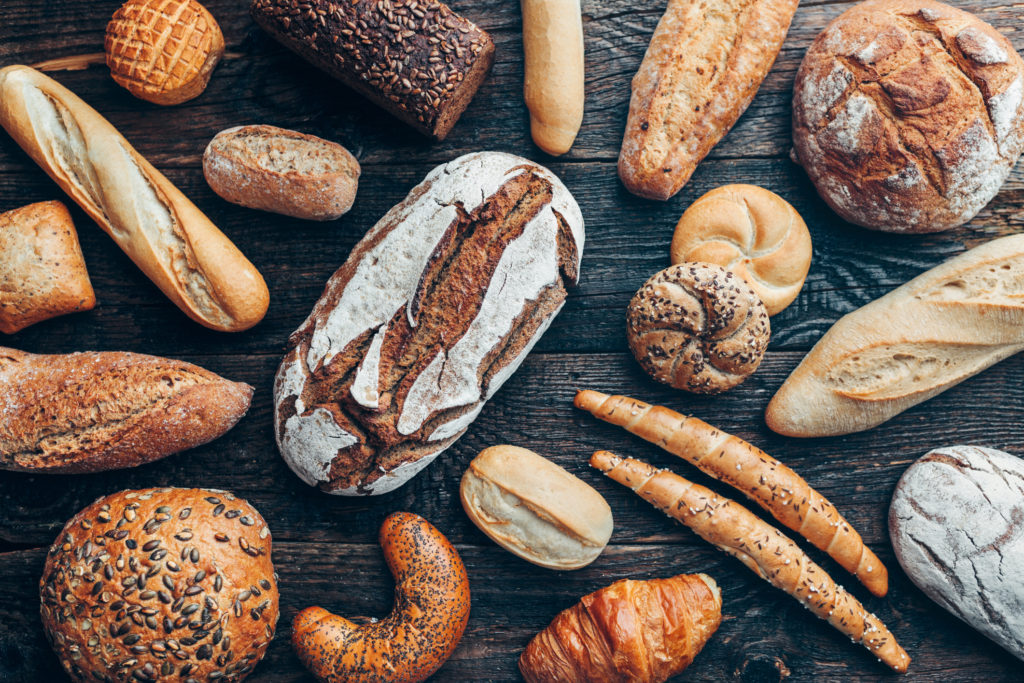When trying to control phosphorus in your diet, it is recommended to always check the ingredient lists of foods to see if there is a phosphorus additive since additives are absorbed better than natural phosphorus.
This post may contain affiliate links through which we may earn a small commission to help keep this website free.
Table of Contents
Why do baked goods contain phosphorus additives?
If you’ve been doing this for a while, you might have noticed that a lot of baked goods have a phosphorus additive in them. There are many different kinds of additives out there that are used for a variety of different reasons, however the most common reason that baked goods frequently have a phosphorus additive is because a lot of baked goods have baking powder in them.
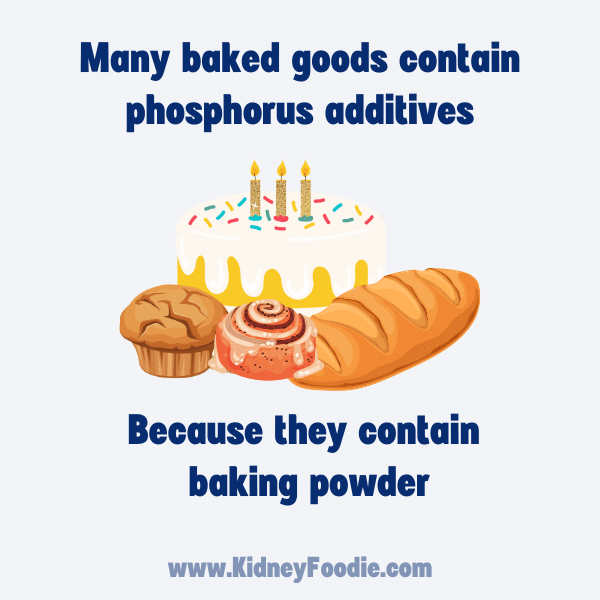
Baking powder is added as a leavening agent to help make foods fluffier. If you skip the baking powder in a recipe, then your recipe may come out denser or flatter than you hoped. If you’ve ever baked something from scratch and used baking powder, then you may be thinking “Oh, Lauren, we don’t even really use that much baking powder. It’s only a little bit!”
However, baking powder is just one big phosphorus additive – and I mean BIG. One tablespoon of baking powder (which is a typical amount called for in many cake recipes) can have 1,368mg of phosphorus. If the recipe makes 12 slices, then each slice would contain over 114mg of phosphorus additive just from the baking powder (which is a lot).
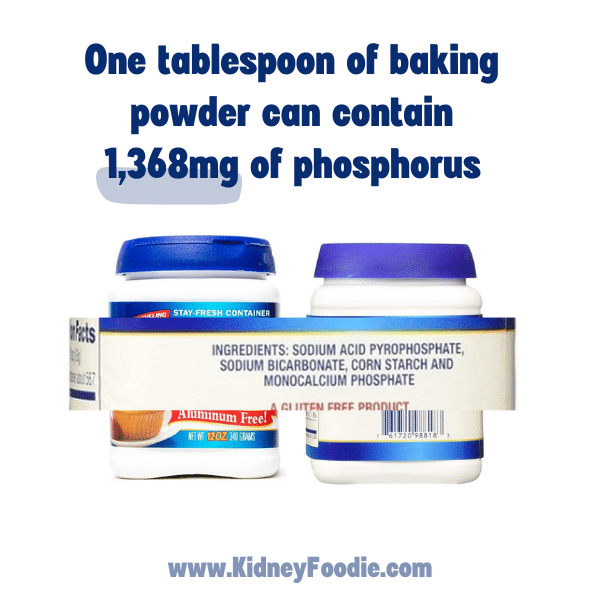
Phosphorus free baking powders
If you do a lot of baking at home where you use baking powder, just go ahead and throw out the baking powder that you have in your cupboards because it is loaded with phosphorus. You’ll want to replace it with a baking powder that does not contain phosphorus.
Phosphorus free baking powder recipe
One of the easiest replacement options for baking powder is to make your own. You can make your own baking powder by mixing cream of tartar and baking soda together.
You use 2 parts cream of tartar and 1 part baking soda. Mix it well and then you can use it just like baking powder in any recipe.
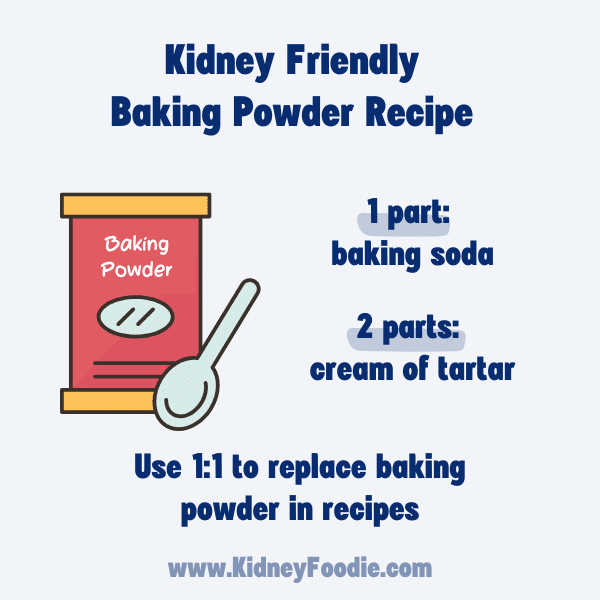
For example, if a recipe requires 1 tablespoon of baking powder, you will just use 1 tablespoon of this kidney friendly baking powder. I know some people even use the same old baking powder container and just empty out the phosphorus baking powder and then store their kidney friendly baking powder in the same container. If you do that, I just recommend writing “kidney friendly” on it somewhere so you know that it is the kidney friendly version.
Note: this recipe will add 1,260mg of sodium to a recipe per tablespoon used. You can offset this sodium by using 1/2 teaspoon less of salt called for in the recipe.
Phosphorus free baking powder you can buy
One other baking powder option that I’ve seen is this baking powder substitute from a brand called Ener-G.
This baking powder is made of calcium and magnesium. It advertises itself as being made especially for people on dialysis, however I would recommend that anyone on dialysis talk to their dietitian before trying this. Many people on dialysis should avoid added calcium in their diet.

For people who are not on dialysis and have chronic kidney disease, I would also check with your dietitian on whether the extra calcium would be good or bad. Like many other nutrients, you want to make sure that you are getting enough calcium, but not too much.
For people with CKD who may be following a more plant based diet, it can sometimes be difficult to get in enough calcium. Using this kind of baking powder that contains calcium may not be a bad thing.
If you’re already getting enough calcium in your diet, then you don’t want to add more. Definitely check with your dietitian.
One benefit of the Ener-G baking powder is that it doesn’t contain sodium, which can be helpful if you’re having a hard time getting your sodium down to the recommended 2,300mg per day.
If you choose to use this baking powder, I would recommend reading the instructions carefully as well as probably browsing the online reviews, such as those you see on Amazon. According to the manufacturer’s instructions, you have to use twice as much of this baking powder compared to regular baking powder.
Based on reviews, it also seems like there are some nuances with how certain types of food might turn out, so read up before baking just so you end up with the best possible final product.
Are baked goods kidney friendly?
Regardless of which baking powder substitute you choose, using a phosphorus free baking powder will make your baked good a better choice in terms of being kidney friendly, but it doesn’t give you a license to eat an unlimited amount.
A lot of baked goods are going to be high in sugar, which is not great for anyone. I always recommend limiting sweets to just 10% of your daily calories, which is also the recommendation in the Dietary Guidelines for Americans. If you eat a lot of sweets, then you’re probably not getting enough of the real kidney super foods like vegetables, fruits, whole grains, and legumes.
Another consideration is that baked goods are typically going to be very starchy and high in carbohydrates, so especially if you have diabetes, choosing a kidney friendly baking powder doesn’t erase the fact that the foods is still going to be very high in carbohydrates and should be eaten in appropriate portion sizes (so just keep that in mind).
Alternative low phosphorus baking methods
In addition to baking powder substitutes, there are some other options for getting fluffy bakery items without the phosphorus additives. Different baking methods can be used to incorporate air into a baked good that don’t require any baking powder at all such as using whipped egg whites or steam.
Another common method would be to use yeast. Making yeast breads is one way to making bread fluffier without using baking powder. You can either use the yeast you buy at the store, or breads like sourdough are actually made with what is known as a wild yeast.
Is sourdough bread good for CKD patients?
I often hear people say that sourdough bread is the best kind of bread for people with kidney disease. One of the reasons that people say this is because sourdough bread is not traditionally made with baking powder, which means that it would not typically contain phosphorus additives.
Out of the 341 different sourdough breads listed in the USDA Food Data Central database, only 10% of them contained a phosphorus additive (compared to 31% of breads overall in the database).
If you are buying storebought sourdough, just be sure to check the food labels. Aside from that lack of phosphorus additives in most sourdough breads, there is nothing really special about sourdough bread. There are plenty of other bread options on the market that don’t contain additives.
Low phosphorus store bought bakery items
But what if you don’t like to bake from scratch? If you want to enjoy a baked good from time to time, but don’t enjoy baking then there are still options.
Compare food labels to find options with no phosphorus additives
Depending on what you want to eat, there are likely alternative options that you can identify by checking the ingredient list for phosphorus additives.
For example, with breads, there are actually plenty of options out there that do not contain any phosphorus additives, so you can usually find an almost identical product that does not contain a phosphorus additive. For example, the whole wheat bread on the left here contains phosphorus additives while the whole wheat bread on the right does not contain any additives.

Choose options that typically do not contain additives
In other circumstances, it might be best to substitute a different food entirely. If you’re out and don’t have access to nutrition information, then consider some of the safer choices for baked goods in terms of phosphorus additives. These are going to be things that don’t traditionally contain baking powder such as brownies or cookies. Compare that to cake where the vast majority of cakes are going to have a lot of baking powder.
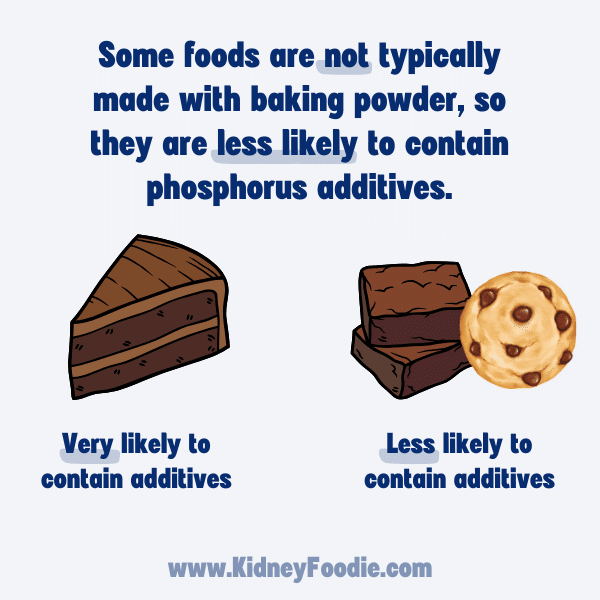
Limit portion size
If your only option is a food that you know has a lot of phosphorus – whether because you can read the label or because you know that those types of foods, then your best bet is going to be portion control. Three pancakes are going to have more phosphorus additives than one pancake.

If you found this information useful and want more kidney friendly nutrition information, sign up for our free newsletter.


